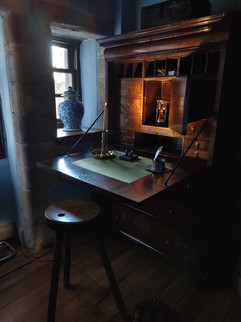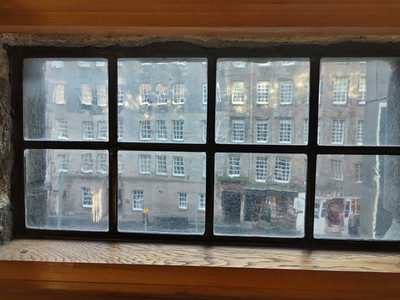If the walls could talk at Gladstone’s Land tenement building in Edinburgh, they would sure have a lot to say. Now, before I start, I need to preface this post with an important clarification. I've mentioned the word 'tenement’, and that probably invokes images of a poverty-stricken slum. However, this isn’t the case in Scotland where tenement just means a multi-occupancy property.

The building is situated in the heart of Edinburgh’s Old Town and dates to 1501. However, its name comes from Thomas Gladstone who bought the property in the early 17th century. Gladstone’s Land is now owned and run by the National Trust for Scotland (NTS).
When you visit, you start at the top of the building and work your way down. As you navigate the winding staircase up to the third floor, it truly is as if you are stepping back in time. The third floor represents a room from an early 20th century boarding house, and, in 1911, it was run by Mary Wilson. According to Gladstone’s Land, boarding houses were a popular option for working class men at the time. The accommodations were modest, but clean and provided an affordable place to live.
One of my favourite parts of this room is the exquisitely painted ceiling (pictured below) that dates to around 1620. These are a popular feature in historic buildings in Scotland and long-time readers might remember the painted ceiling in our article on the John Knox House.

The NTS does a fabulous job at providing a real sense of the social history throughout the building with lovely little details found everywhere you look. Mary’s boarding house room appears as if the tenants have just left for work and could return at any moment.
Continuing our exploration down to the second floor, we now go further back in time to the mid-18th century.

This room represents the draper’s shop that belonged to William Dawson and Elizabeth Pillans in 1766. The lovely wares of the shop are on display.

One fun aspect of Gladstone’s Land is that you are allowed to touch things and are encouraged to explore the items in each room.
Our visit to the 1700s has been nice, but we must continue down to the first floor for a wee look at how the building would have looked in the 1600s. Entering the first room, my breath caught a bit at the incredible contents that surrounded me.

It’s 1632 and this is the apartment of the wealthy merchants, John Riddoch and Margaret Noble. The apartment consists of a large room, kitchen, and stockroom. According to the NTS, Riddoch and Noble ran a shop on the ground floor and tavern in the basement.
Starting in their large room, this is where John and Margaret would have relaxed, socialized, and slept. The gorgeous furniture and decorations are an incredible demonstration of their wealth and come from all around the world.
As you exit the main room, you enter the warmth of the kitchen. While there are items you would expect to find in this room, there is also a bit of an unexpected feature tucked into the corner. There, you can see a modest bed laid out on the floor. This was where the servant of the house slept. During the day, the bed would fold up against the wall out of the way.
Our last stop on our tour of the building at Gladstone’s Land is the stockroom. Now that might sound a bit unremarkable, but don’t be fooled by the nondescript name because this room has a few wee hidden gems. Pride of place on the wall is a magnificent tapestry.

What Gladstone’s Land particularly excels at is highlighting the wee details that can be found throughout the building. For example, evidence of one fun fact can be found on the ground floor in the coffee shop.
Remember how I mentioned that John Riddoch and Margaret Noble ran a tavern from the basement? Well, a popular bar snack at the time were oysters. We reference this in our article on the Museum on the Mound. Recently, while doing renovations, the NTS found that the gaps in the masonry of the walls of Gladstone’s Land were filled, in part, with oyster shells. If you visit, be sure to keep an eye out for the wall in the coffee shop where you can see a preserved view.
Speaking of the coffee shop, it’s important to note that it is also an ice cream parlour. On one of our visits, we decided to sample both some of their delicious ice cream and a pastry. This was done all in the name of research of course. 😉
I often go to the Gladstone’s Land as I find it a nice place to get a coffee, relax, and even get a wee bit of work done. It’s location is conveniently located just off the Royal Mile.
If you come to Edinburgh, we highly recommend you visit Gladstone’s Land for a fascinating peek back into history. Be sure to head to their webpage on the National Trust for Scotland website for more information on how to plan your visit. Additionally, we are proud members of the NTS and highly recommend getting a membership if you plan on visiting more than a few properties in a year’s time.
Of course, while you’re in town, Sami (our human tour guide) and Sawyer (our Golden Retriever tour guide) would love to show you around. Our Wee Golden Walks often go right by Gladstone’s Land so you’ll know where to go after your tour with us.
We hope you have enjoyed this brief visit to this captivating historical landmark. Be sure to subscribe to our blog so that you can get our articles on Edinburgh and sites around Scotland as soon as they’re published.
Until next time- Explore & Discover!








































